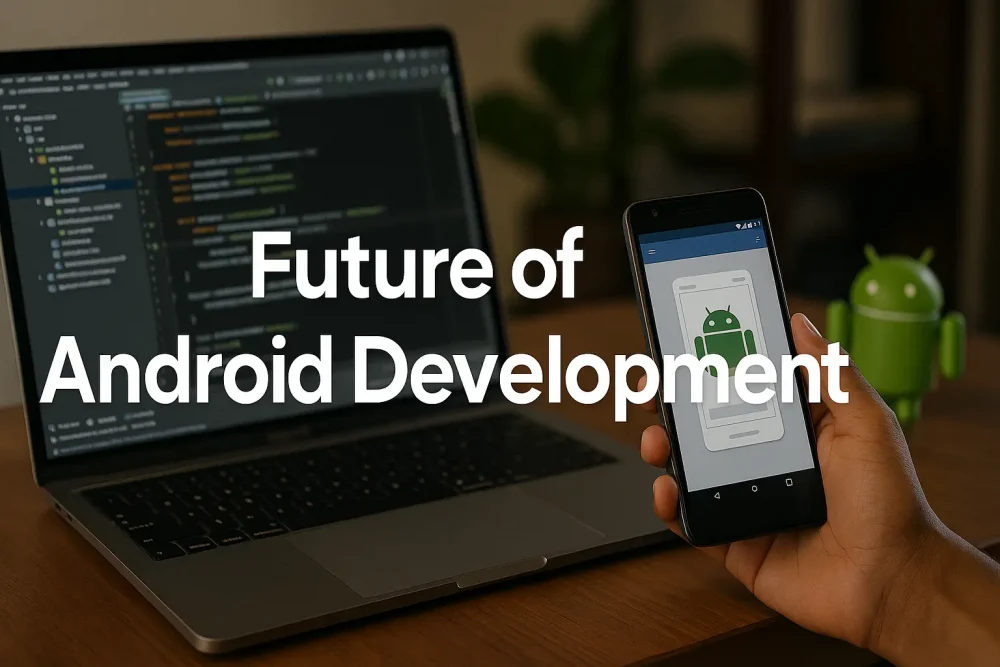Remember when Android updates meant minor improvements? These small improvements were a UI update or security updates. Nothing major.
However, as we head to 2026, we will see such advances that will surprise you! Technology has changed and so has the future of Android development.
Wearables and AR/VR technologies are the new reality. In this article, we are going to see what the future holds. Android 15 features are now far more advanced.
What the Future of Android Development Holds
The future looks promising. Android customers will have more personal and more intuitive experiences. The 5G will ensure faster loading of apps, and the better safety features will help protect personal information.
Here are 9 things you should look out for:
1) Moving Past Chatbots
AI chatbots are useful. Businesses will continue to rely on them to handle customer inquires.
One of the major AI integration trends will be Agentic AI. These AI systems take traditional tools to a whole new level. It’s designed to make decisions on your behalf and complete difficult tasks with minor human intervention.
But for Agentic AI to work, you must provide correct and complete data. Or else, the output will be incorrect and biased.
2) Jetpack Compose and Kotlin Evolution
The toolkit used for Android has also developed tremendously. These developments have helped developers to reuse their code and improve productivity.
Jetpack Compose future is moving closer to the “Write once and run everywhere paradigm”. It’s become quite useful for developers to see their data live and have it updated automatically.
Similarly, Kotlin’s Evolution has firmly established itself as the goldmine for Android development. Kotlin’s multiplatform will allow developers to write the core logic once and use it for Android, web, and iOS.
3) Cross-Platform Direction
The battle between native and cross-platform is over. Flutter and React Native have been used by businesses such as BMW and Walmart to develop their applications. They took cross-platform direction because they:
- Didn’t want to sacrifice speed or quality
- Cut development costs by 50% to 60%
- Adapt easily to devices like IoT and foldable devices.
The future of Android development now lies in using cross-platform tools, especially if you want to reach your customers fast.
4) Wearable Expansion
Android isn’t just restricted to phones. Designing for these devices will be minimal compared to mobile devices. Wearable expansion will have 5G connectivity and chips for biometric tracking.
With these smartwatches, customers can keep track of their health and get suggestions to improve their health. These smartwatches will strongly influence the future of Android development.
5) Security Updates
Google’s commitment to security has become evident in its monthly Security Update Bulletin. These patches deal with weaknesses, and they contribute to the maintenance of customer confidence.
Privacy is now compulsory to ensure that cyber-attacks do not occur. This implies that you will have to exercise data mining.
You’ll need to be transparent with customers on how their data is going to be used. If you need expert guidance on security, you can hire Android App Developer.
6) Inclusive and Accessible Design
Accessibility has become non-negotiable for several brands. If your Android app is accessible to disabled customers, you’ll be recognized as a socially responsible Android App Development Company.
Adding features like voice commands, touchless interfaces, and gestures is helping customers with limitations use their Android app.
7) Mastering Foldable Devices
Foldable devices and large-screen devices allow developers to create a unique experience for their customers. When youhire Android app developer, they will assist you in coming up with a well-thought-out design and provide you with flexible layouts.
The biggest leaders in foldable devices are Samsung and Huawei. These devices will be the future of Android development of offering multitasking and game experience.
8) Cloud Native Android
This is a modern approach to building Android apps. Cloud native architecture helps developers break down the app into smaller chunks called containers. They’re usually lightweight and ensure users have a consistent user experience.
Cloud Native Android applies the technology of edge computing and real-time databases to develop a resilient app. If you need expert guidance, you can contact an Android app development company.
9) WebAssembly
Lastly, WebAssembly is thought to be a completely new technology for developing high-performance apps. This tool was initially used for creating web applications but has extended into mobile app development today.
The most desirable aspect of this tool is that it operates in a sandboxed environment. It aids in enhancing the security of the app regarding code injection attacks and memory corruption.
Conclusion
Android development has a bright future. Some technologies are coming in to enhance the user experience and cover a wider range of audiences.
To adapt and stay relevant in 2026, you will need to use this new technology some day or the other. If you’re still stuck with Android 15 features, your competitors will leave you in the dust.
To use these AI integration trends, you’ll be expected to create a strategy that creates user value. You’ll either make the most of these technologies or fight to be relevant in 2026. The choice is yours.
